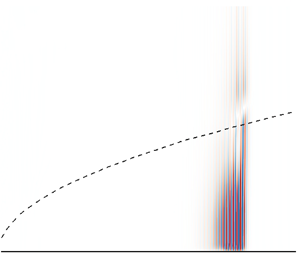Article contents
Reactive control of second Mack mode in a supersonic boundary layer with free-stream velocity/density variations
Published online by Cambridge University Press: 05 January 2023
Abstract

We consider closed-loop control of a two-dimensional supersonic boundary layer at  $M=4.5$ that aims at reducing the linear growth of second Mack mode instabilities. These instabilities are first characterized with local spatial and global resolvent analyses, which allow us to refine the control strategy and to select appropriate actuators and sensors. After linear input–output reduced-order models have been identified, multi-criteria structured mixed
$M=4.5$ that aims at reducing the linear growth of second Mack mode instabilities. These instabilities are first characterized with local spatial and global resolvent analyses, which allow us to refine the control strategy and to select appropriate actuators and sensors. After linear input–output reduced-order models have been identified, multi-criteria structured mixed  $H_{2}$/
$H_{2}$/ $H_{\infty }$ synthesis allows us to fix beforehand the controller structure and to minimize appropriate norms of various transfer functions: the
$H_{\infty }$ synthesis allows us to fix beforehand the controller structure and to minimize appropriate norms of various transfer functions: the  $H_{2}$ norm to guarantee performance (reduction of perturbation amplification in nominal condition), and the
$H_{2}$ norm to guarantee performance (reduction of perturbation amplification in nominal condition), and the  $H_{\infty }$ norm to maintain performance robustness (with respect to sensor noise) and stability robustness (with respect to uncertain free-stream velocity/density variations). Both feedforward and feedback set-ups, i.e. with estimation sensor placed respectively upstream/downstream of the actuator, allow us to maintain the local perturbation energy below a given threshold over a significant distance downstream of the actuator, even in the case of noisy estimation sensors or free-stream density variations. However, the feedforward set-up becomes completely ineffective when convective time delays are altered by free-stream velocity variations of
$H_{\infty }$ norm to maintain performance robustness (with respect to sensor noise) and stability robustness (with respect to uncertain free-stream velocity/density variations). Both feedforward and feedback set-ups, i.e. with estimation sensor placed respectively upstream/downstream of the actuator, allow us to maintain the local perturbation energy below a given threshold over a significant distance downstream of the actuator, even in the case of noisy estimation sensors or free-stream density variations. However, the feedforward set-up becomes completely ineffective when convective time delays are altered by free-stream velocity variations of  $\pm$5 %, which highlights the strong relevance of the feedback set-up for performance robustness in convectively unstable flows.
$\pm$5 %, which highlights the strong relevance of the feedback set-up for performance robustness in convectively unstable flows.
- Type
- JFM Papers
- Information
- Copyright
- © The Author(s), 2023. Published by Cambridge University Press
References
REFERENCES
- 3
- Cited by





